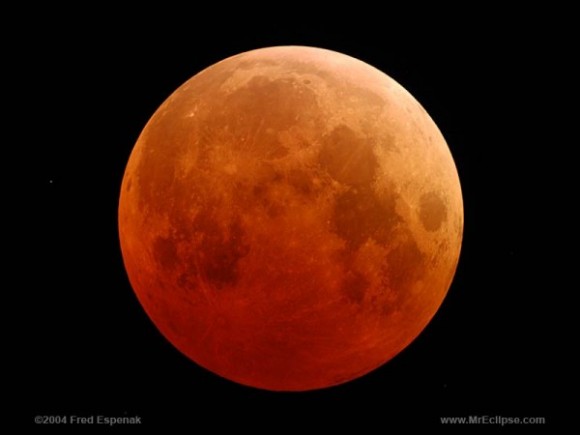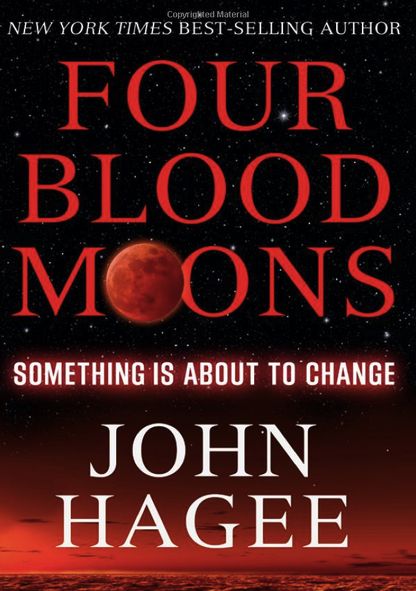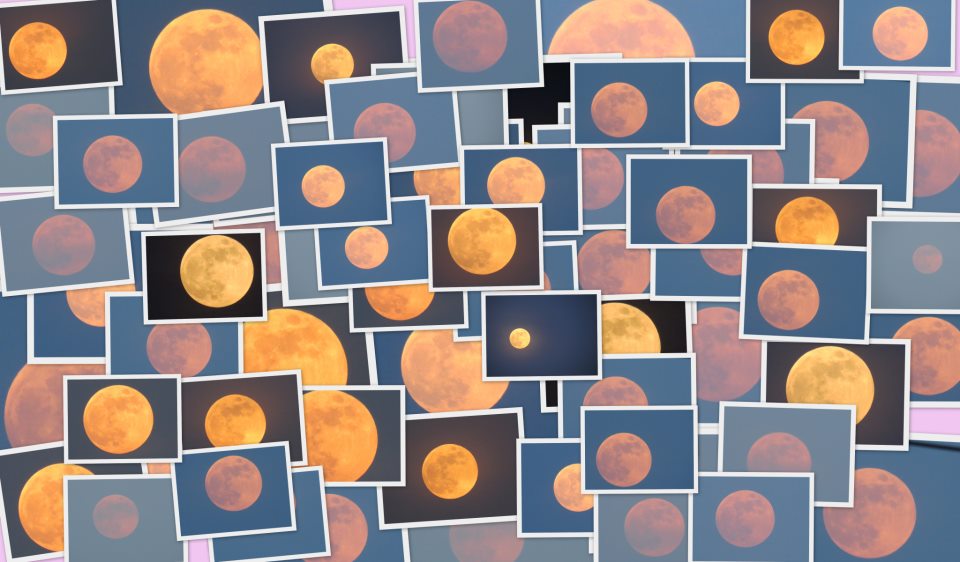Most of us in astronomy had not heard the term Blood Moon to describe a lunar tetrad until a few years ago, but now the term has gained widespread use in the media. The origin of the term is religious, at least according to Christian pastor John Hagee, who wrote a 2013 book about Blood Moons. We at EarthSky don’t have any special knowledge about the Blood Moons of Biblical prophesy. But, since they’re moons and since people are asking us, we wanted to provide some info. Follow the links below to learn more about Blood Moons.
Super Blood Moon eclipse on night of September 27-28
Blood Moons in Biblical prophecy
Dates of Biblical prophecy Blood Moons in 2014 and 2015
How common is a tetrad of total lunar eclipses?
Why is the term Blood Moon being used to mean a full moon of a lunar tetrad?
Other times in astronomy you hear “moon” and “blood” in same sentence.
Dates of Harvest and Hunter’s Moons in 2014 and 2015

This is what a total eclipse looks like. This is the total eclipse of October 27, 2004 via Fred Espenak of NASA. Visit Fred’s page here. We astronomy writers often describe a totally eclipsed moon as appearing ‘blood red.’ Here’s why the moon turns red during a total eclipse.
What is a lunar tetrad? Both astronomers and followers of certain Christian pastors have been talking for many months about the lunar tetrad of 2014-2015. What is a tetrad? It’s four successive total lunar eclipses, with no partial lunar eclipses in between, each of which is separated from the other by six lunar months (six full moons).
The first Blood Moon eclipse in the ongoing series of four happened on the night of April 14-15, 2014. The second one took place was October 7-8, 2014, and the third one (the shortest total lunar eclipse of the 21st century) was April 4, 2015. The fourth and final total lunar eclipse of the ongoing lunar tetrad – four total lunar eclipses in a row, spaced at six full moons apart – will fall on the night of September 27-28. It’ll be visible to sky watchers in North America. Some will call it a Blood Moon.
Blood Moons in Biblical prophecy. We’re not experts on prophecy of any kind. But we’ll tell you what we know about the new definition for Blood Moon that has raised so many questions in the past few years.
From what we’ve been able to gather, two Christian pastors, Mark Blitz and John Hagee, used the term Blood Moon to apply to the full moons of the ongoing tetrad – four successive total lunar eclipses, with no partial lunar eclipses in between, each of which is separated from the other by six lunar months (six full moons) – in 2014 and 2015. John Hagee appears to have popularized the term in his 2013 book Four Blood Moons: Something is About to Change.
Mark Blitz and John Hagee speak of a lunar tetrad as representing a fulfillment of Biblical prophecy. After all, the moon is supposed to turn blood red before the end times, isn’t it? As described in Joel 2:31 (Common English Bible):
The sun will be turned to darkness, and the moon to blood before the great and dreadful day of the LORD comes.
That description, by the way, sounds like a combined total solar eclipse and total lunar eclipse. It sounds like a description of a total eclipse by someone who perhaps has never seen one. Sun turned to darkness = moon directly between the Earth and sun in a total solar eclipse. Moon turned to blood = Earth directly between the sun and moon, Earth’s shadow falling on the moon in a total lunar eclipse. Solar and lunar eclipses are very ordinary and frequent happenings that have occurred many times in our lifetimes, but they don’t happen, can’t happen, ever, on the same day.

This book, published in 2013, is apparently what launched all the questions to our astronomy website about Blood Moons. We confess. We haven’t read it.
Dates of Biblical prophecy Blood Moons in 2014 and 2015. These are the dates for the ongoing tetrad – four successive total lunar eclipses – in these years.
2014:
Total lunar eclipse: April 15
Total lunar eclipse: October 82015:
Total lunar eclipse: April 4
Total lunar eclipse: September 27-28
There are a total of 8 tetrads in the 21st century (2001 to 2100). But proponents of this Biblical prophecy regard the ongoing tetrad as especially significant because it coincides with two important Jewish holidays: Passover and Tabernacles.
The April 2014 and April 2015 total lunar eclipses align with the feast of Passover. The October 2014 and September 2015 total lunar eclipses align with the feast of Tabernacles.
The Jewish calendar is a lunar calendar. In any year, it’s inevitable that a full moon should fall on or near the feasts of Passover (15 Nissan) and Tabernacles (15 Tishri). Nissan and Tishri are the first and seventh months of the Jewish calendar, respectively.
It is somewhat ironic that three of these four lunar eclipses are not visible – even in part – from Israel. The only eclipse that can be seen at all from Israel is the tail end of the September 28, 2015 eclipse, which may be observable for a short while before sunrise.
How common is a tetrad of total lunar eclipses? Depending upon the century in which you live, a lunar tetrad (four consecutive total lunar eclipses, spaced at six lunar months apart from one another) may happen fairly frequently – or not at all.
For instance, in our 21st century (2001-2100), there are a total 8 tetrads, but in the 17th, 18th and 19th centuries, there were none at all. If we include all the centuries from the 1st century (AD 1-100) through the 21st century (2001-2100), inclusive, there are a total of 62 tetrads. The last one occurred in 2003-2004, and the next one after the 2014-2015 tetrad will happen in 2032-2033.
However, if we want to know which tetrads specifically fell on the Jewish feasts of Passover and Tabernacles, there appear to be a total of 8 in these 21 centuries:
1. 162-163 C.E. (Common Era)
2. 795-796 C.E.
3. 842-843 C.E.
4. 860-861 C.E.
5. 1493-1494 C.E.
6. 1949-1950 C.E.
7. 1967-1968 C.E.
8. 2014-2015 C.E.
Why is the term Blood Moon being used to mean a full moon of a lunar tetrad? We can’t really tell you why more and more people are using the term Blood Moon to describe the four full moons of a lunar tetrad. We don’t know why, exactly.
Here’s the definition of a lunar tetrad, again: four successive total lunar eclipses, with no partial eclipses in between, each of which is separated from the other by six lunar months (six full moons). There’s no obvious reason why Blood Moon should be associated with this term.
To the best of our knowledge, however, the use of the term Blood Moon to describe a lunar tetrad is of recent origin. It might have originated with John Hagee’s 2013 book.
We’re still not sure whether Blood Moon pertains to the full moon of any tetrad, or specifically to a tetrad that coincides with the feasts of Passover and Tabernacles.
Either way, the nouveau definition of Blood Moon has definitely gained traction during the interval of the ongoing tetrad, the four total lunar eclipses of 2014 and 2015.

View larger. | Hunter’s Moon collage from EarthSky Facebook friend Kausor Khan in Hyberabad, India. Notice that she choose reddish moons to depict the Hunter’s Moon. That’s because many people see the Hunter’s Moon low in the sky, and moons seen low in the sky appear reddish.
Other times in astronomy you hear “moon” and “blood” in same sentence. The full moon nearly always appears coppery red during a total lunar eclipse. That’s because the dispersed light from all the Earth’s sunrises and sunsets falls on the face of the moon at mid-eclipse. Thus the term blood moon can be and probably is applied to any and all total lunar eclipses. We astronomy writers often say a totally eclipsed moon looks blood red. Why? Mainly because it sounds dramatic, and a lunar eclipse is a dramatic natural event. Read more here: Why does the moon look red during a total lunar eclipse?
What’s more, in folklore, all the full moons have names. The names typically coincide with months of the year, or seasons. One of the most famous moon names is the Hunter’s Moon. It is the the full moon immediately following the Harvest Moon, which is the full moon occurring most closely to the autumnal equinox.
The Hunter’s Moon, in skylore, is also sometimes called the Blood Moon. Why? Probably because it’s a characteristic of these autumn full moons that they appear nearly full – and rise soon after sunset – for several evenings in a row. Many people see them when they are low in the sky, shortly after they’ve risen, at which time there’s more atmosphere between you and the moon than when the moon is overhead. When you see the moon low in the sky, the extra air between you and the moon makes the moon look reddish. Voila. Blood Moon.
Dates for the Northern Hemisphere’s Harvest and Hunter’s Moons in 2015:
2015:
Autumn Equinox: September 23
Harvest Moon: September 27-28
Hunter’s (Blood) Moon: October 27
Bottom line: The term Blood Moon in Biblical prophecy appears to have been popularized by two Christian pastors, Mark Blitz and John Hagee. They have used the term Blood Moon to apply to the full moons of the ongoing tetrad – four successive total lunar eclipses, with no partial lunar eclipses in between, each of which is separated from the other by six lunar months (six full moons). The fourth and final lunar eclipse in an ongoing tetrad – four lunar eclipses in a row – happens on September 27-28, 2015.
credit link: http://earthsky.org/space/what-is-a-blood-moon-lunar-eclipses-2014-2015

